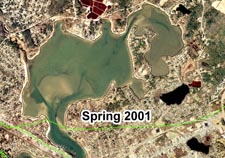Historical Eelgrass Abundance: Buttermilk Bay
Note: The data and maps on this page will be included in a forthcoming report summarizing changes in eelgrass distribution in Buzzards Bay. The information is posted here to facilitate review of the information, but the data should be considered to be in draft form and subject to change.
Summary
Buttermilk Bay is a small embayment that for decades was dominated by eelgrass beds, particular on the flood delta in the center of the bay. Post wasting-disease, eelgrass appeared to peak in abundance in bay during the 1980s, but today eelgrass beds have died off, except for possible a few patchy areas in the channel entrance to the bay.
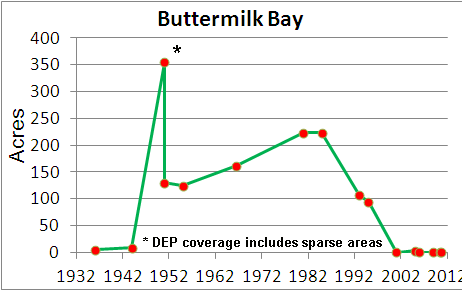
Mooring Impacts
Eelgrass has died off in Buttermilk Bay, presumably largely the result of eutrophication. Mooring scars were visible in the eelgrass beds in the mooring field abutting Hideaway Village in some aerial photographs from past decades.
Previously Reported Summaries and Historical Trends
Buttermilk Bay is the only site in Buzzards Bay where re-colonization of eelgrass was mapped after the wasting disease (Stevens 1935, 1916, Stevens et al., 1950). Buttermilk and Little Buttermilk Bay was also extensively sampled and mapped by Costa (1988a), including the analysis of three sediment cores to document historical abundance prior to recorded information. With respect to the sediment cores and historical trends, Costa noted, “In Buttermilk Bay, eelgrass was widespread prior to the wasting disease (Stevens, 1935, 1936), and photographs show a broad recovery during the 1940’s and 1950’s. Eelgrass was somewhat less abundant near this core during the early 1960’s, but has expanded since then. Given these observations, and assuming rates of deposition are similar to Waquoit Bay, it appears that the wasting disease began at 27 cm. If sedimentation rates were similar prior to the wasting disease, the earlier decline occurred ~1903”
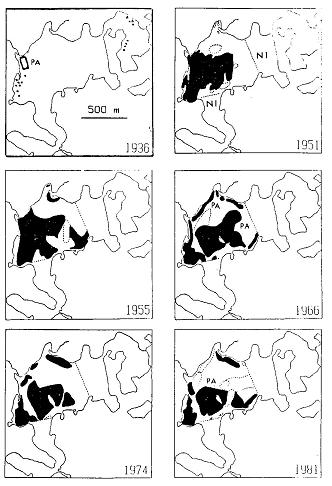
Buttermilk Bay eelgrass maps from Costa (1988b). Eelgrass in Little Buttermilk and eastern Buttermilk were excluded from this graphic from the 1988 report because photographs for these areas were not available for all dates.
Other observations by Costa included, “During the 1960’s, eelgrass began to extensively colonize Little Buttermilk Bay, and grew deeper in Buttermilk Bay than during any other recent period (Fig. 14, 15 bottom). Total eelgrass cover in the central part of Buttermilk Ray in 1966 was unchanged from the 1950’s (Fig. 15 top) because of losses due to dredging and new declines in poorly flushed coves. For example, eelgrass was present in Hideaway Village Cove during the 1950’s, but largely disappeared by 1966. Today no eelgrass grows along the inner shore of this cove. Eelgrass continued decline in the deepest parts of the Ray during the 1970’s and 1980’s (Fig. above, bottom) but greatly expanded in Little Buttermilk Bay and other shallow areas.”
“The losses of eelgrass in the deep portions of the Bay and in some poorly flushed roves appear related to nutrient loading or increased turbidity. Today, eelgrass is absent from areas with the highest nutrients concentrations, depth of growth in Buttermilk Ray correlates with dissolved inorganic nitrogen content. of seawater (Costa, 1988).
Overall, Buttermilk Bay has not experienced the large declines observed in other highly developed bays. This is probably due to the high flushing rate, and because the Ray is so shallow, most beds are not at the lower depth limit of growth. The loss of some vegetation since the 1960’s: however, suggests that Buttermilk Bay may be affected by future increases in nutrient loading and sediment resuspension.”
Costa also sampled periphyton and nutrients along gradients in the bay. With respect to the nutrient and periphyton sampling, he noted “To identify what levels of nutrient loading cause these changes, concentrations and inputs of dissolved inorganic nitrogen (DIN) in Buttermilk Bay were measured. Periphyton on eelgrass leaves and plastic screen strips on floats correlated well to mean DIN. Experimental floats released nutrients and demonstrated that small increases in DIN significantly increase periphyton abundance. The depth of eelgrass growth in Buttermilk Bay decreased by 9 cm for every 1 increase in DIN. Periphyton abundance is more important than phytoplankton concentrations in limiting eelgrass growth in Buttermilk Bay, because water in this bay has a short residence time, and phytoplankton gradients are less prominent.”
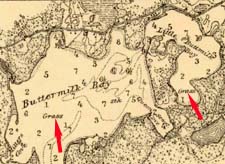
On many nautical charts of the period 1890 to 1930 (prior to the wasting disease), in certain shallow bays where eelgrass is a dominant feature, eelgrass is indicated by “grass.” The figure above shows Buttermilk Bay for a National Ocean Survey Nautical chart from 1899. In a 1974 chart, eelgrass was only shown at the south end of little Buttermilk Bay, but in a 1984 chart, after eelgrass had extensively and persistently returned, new “grass” areas were again denoted as shown in the chart below.
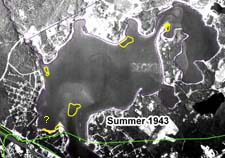
This aerial photograph of Buttermilk Bay, taken in the summer of 1943, just a decade after the wasting disease, shows virtually no eelgrass in the Bay. Even those areas delineated are sparse and in some cases may be of uncertain identity. The speckled areas south of Red Brook is presumed to coincide with the patches of vegetation described by Stevens at about 1936. The dark patches at the south end of Miller Cove could be eelgrass or Ruppia.
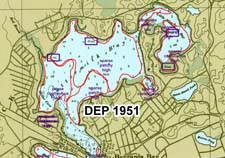
Eelgrass in Buttermilk Bay circa 1951 as mapped by DEP, with polygon attribute features shown. The original source photo was not available, so a 1984 nautical chart is shown. Note the indications of “grass” in the four boxes shown (see comments in figure caption above). As indicated by the density, cover and certainty fields, large areas of the bay were delineated sparse by DEP, so the area is inconsistent (considerably larger) than the BBNEP 1951 interpreted photograph, below, which was probably taken later in the year.
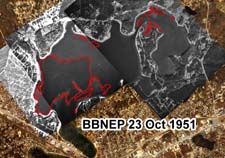
This 23 October 1951 aerial photograph series was interpreted by the BBNEP and omits the very sparse deep areas and other uncertain vegetation types.
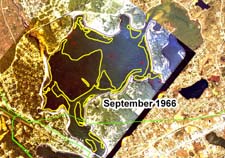
Eelgrass in Buttermilk Bay on 17 September 1966. This image omits Little Buttermilk Bay and is therefore an underestimate.
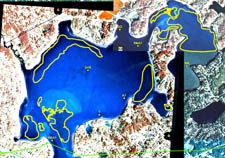
Eelgrass in Buttermilk Bay estimated on a 4 April 1993 Infrared image. This is an early season photograph, and many eelgrass beds in Buttermilk Bay are sparse this time of year and some beds are functional annuals. Image quality is also poor in some parts of the bay and the image omits Little Buttermilk Bay. For all these reasons, it probably is an underestimate of coverage. Note however that eelgrass remains on the southernmost position of the flood delta.
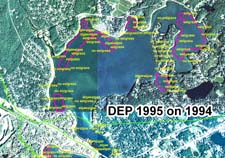
Eelgrass in Buttermilk Bay about summer 1995 as mapped by DEP, including field verification points. The source photo was not available so it was plotted here on a June 1994 color ortho photograph, which is of poor water transparency. Note however the photo documents the loss of eelgrass on the flood delta.
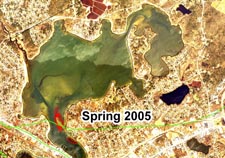
Right: Spring 2005, photo interpreted by the BBNEP. The apparent beds demarcated in the channel of the estuary are of uncertain identity, and could be Codium, or Codium and eelgrass mix. Note that in both photographs the flood delta is devoid of vegetation. There is a band of vegetation on the north slope and base of the flood delta, but this is likely drift material, much of which may be Codium algae attached to small rocks which can accumulate in such patterns.
